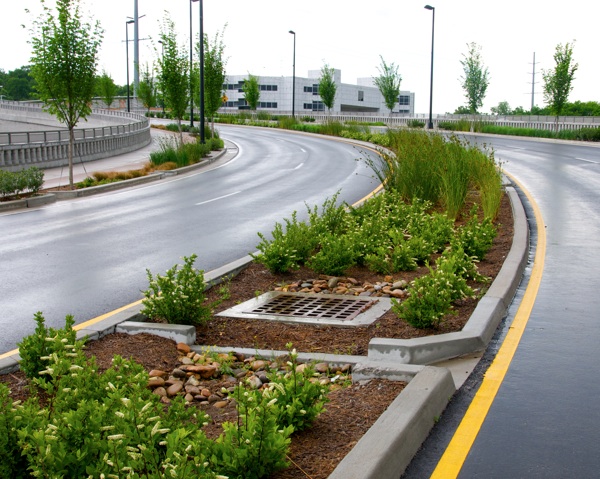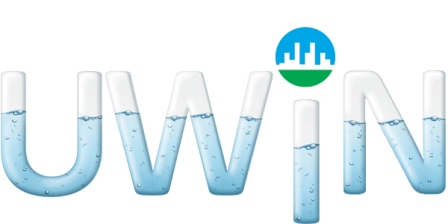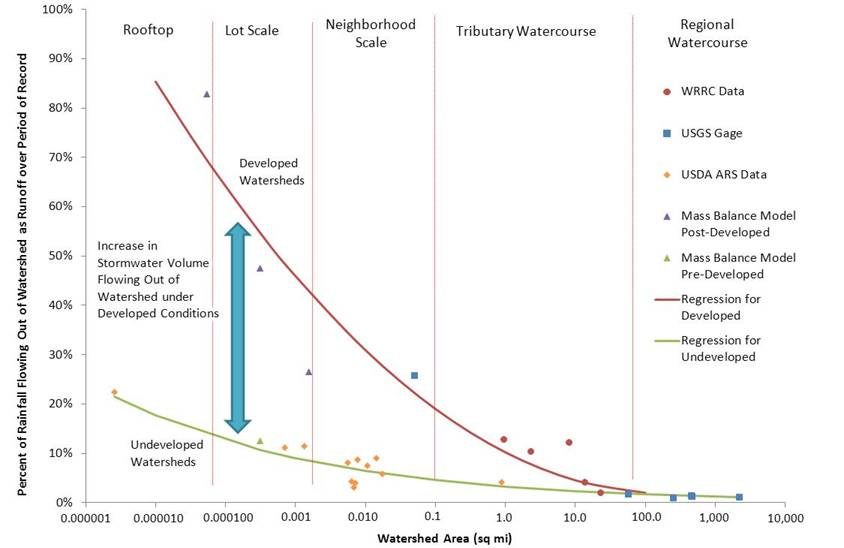Project B2-1: Effects of Green Infrastructure on Urban Systems
Thomas Meixner, PhD
University of Arizona
Hydrology and Atmospheric Sciences
Water sustainability and protection from flood hazards are key challenges in sustaining urban areas in a changing world. One solution that has been offered for both of these challenges is the implementation of a low-impact-development practice called green infrastructure (GI). Green infrastructure can take the form of small or large detention basins that capture and infiltrate storm water. GI can also take the form of green roofs, pervious surfaces, and other mechanisms to divert and infiltrate water in urban environments.
changing world. One solution that has been offered for both of these challenges is the implementation of a low-impact-development practice called green infrastructure (GI). Green infrastructure can take the form of small or large detention basins that capture and infiltrate storm water. GI can also take the form of green roofs, pervious surfaces, and other mechanisms to divert and infiltrate water in urban environments.
Specifically, our team is conducting both observational sciences and modelling to quantify the impact of GI on runoff quantity and quality in urban environments. We are working with collaborators to then further understand how GI can influence flood response in urban environments and determine what level of hazard can be prevented through the use of GI.
These studies involve water quantity and quality observations in select cities to understand the observed impact of GI. We are monitoring streamflow, nutrient export, and other water contaminants. Furthermore, we are also continuing the development and implementation of modelling tools to pursue investigations into which strategies of GI implementation would be most effective at meeting societal goals.
The project will result in information that enables better implementation of GI at either local, lot or city-scale. We have also an emergent citizen science aspect of our project where folks can take pictures of GI and observe how water presence changes over time. While our citizen science program is not yet active, we have some tests being developed for this upcoming spring (2017).
DATA NEEDS
We seek data about the implementation of GI in different cities in the US. Specifically geographic location data combined with what types of systems have been implemented.
DATA USE
We will use this data to develop cross city comparisons and modelling applications in the different cities
Kineros2 Model
We are primarily using the Kineros2 model which is used to model upland and channel environments in arid and semi-arid regions. However, we are extending its application to urban environments in general. The model can also model sediment, carbon and nitrogen cycling in these environments.
Journal Papers
- Crosson, C., Achilli, A., Zuniga-Teran, A. A., Mack, E. A., Albrecht, T., Shrestha, P., … & Scott, C. A. (2020). Net Zero Urban Water from Concept to Applications: Integrating Natural, Built, and Social Systems for Responsive and Adaptive Solutions. ACS ES&T Water. https://doi.org/10.1021/acsestwater.0c00180
- Gerlak, A. K., Elder, A., Thomure, T., Shipek, C., Zuniga-Teran, A., Pavao-Zuckerman, M., … & Meixner, T. (2021). Green Infrastructure: Lessons in Governance and Collaboration From Tucson. Environment: Science and Policy for Sustainable Development, 63(3), 15-24. https://doi.org/10.1080/00139157.2021.1898894
- Ibsen, Peter C., Dorothy Borowy, Tyler Dell, Hattie Greydanus, Neha Gupta, David M. Hondula, Thomas Meixner et al. “Greater aridity increases the magnitude of urban nighttime vegetation-derived air cooling.” Environmental Research Letters 16, no. 3 (2021): 034011. https://doi.org/10.1088/1748-9326/abdf8a
- Korgaonkar Y, Guertin DP, Meixner T, Goodrich DC. Hydrological Modeling of Green Infrastructure to Quantify Its Effect on Flood Mitigation and Water Availability in the High School Watershed in Tucson, AZ. ISPRS International Journal of Geo-Information. 2021; 10(7):443. https://doi.org/10.3390/ijgi10070443
- Korgaonkar, Y., Guertin, D. P., Goodrich, D. C., Unkrich, C., Kepner, W., & Burns, I. S. (2018). Modeling Urban Hydrology and Green Infrastructure using the AGWA Urban Tool and the KINEROS2 Model. Frontiers in Built Environment, 4, 58. https://doi.org/10.3389/fbuil.2018.00058
- Luketich, A. M., Papuga, S. A., & Crimmins, M. A. (2019). Ecohydrology of urban trees under passive and active irrigation in a semiarid city. PloS one, 14(11).
Updated: October 2022
Theses/Dissertations
Anderson, Jack, Ferre, Ty, Whitaker, Martha, and Winter, Larry. Analysis and Classification of Semi-Arid Bioswales in an Urban Setting (2018): M.S. Thesis – Hydrology: https://repository.arizona.edu/handle/10150/631916
Arcelay, Adriana (2019). Investigating Impacts of Projected Climate Change on Flood Risk in Urban Areas Located Along River Channels. Master’s Thesis, University of Arizona. Web: https://repository.arizona.edu/handle/10150/634342
Emler, Lori, (2021). Characterization Of Hydrochemical Evolution and Transport of Nitrogen Species in Semiarid Urban Catchments During Monsoon Rainfall Events Using Hysteresis Analysis. MS Thesis, University of Arizona.
Hermosilla, Victoria (2019). Rainwater harvesting infiltration exploration using Hydrus-1D. Master’s Thesis, University of Arizona. Web: https://repository.arizona.edu/handle/10150/634343
Korgaonkar, Yoganand (2020). Modeling Urban Hydrology and Green Infrastructure Using the AGWA Urban Tool and the KINEROS2 Model. PhD Dissertation, University of Arizona. Web: https://repository.arizona.edu/handle/10150/636556
Swartz, Samantha (2019). Infiltration Rates of Green Infrastructure Curb-Cut Basins: Finding Balance between Function and Aesthetic. Master’s Thesis, University of Arizona. Web: https://repository.arizona.edu/handle/10150/633114
Rockhill, Tyler (2017) “Influence of Soil Physical and Chemical Properties on Soil Co2 Flux in Semi-Arid Green Stormwater Infrastructure”, M.S. Thesis, Hydrology, University of Arizona, December 2017, pp. 63, Tucson, AZ. https://pdfs.semanticscholar.org/3daf/b912dbb014f2f33a40b326ecbc90d48a6911.pdf
Updated: May 2021
Related Materials
 Thomas Meixner, PhD – Principal Investigator
Thomas Meixner, PhD – Principal Investigator
Professor
Hydrology and Atmospheric Sciences
University of Arizona
Voice: (520) 626-1532
Email: tmeixner@email.arizona.edu
My research interest lies at the intersection of hydrology and biogeochemistry. In particular I am interested in how hydrologic processes play a fundamental role in controlling biogeochemical processes and fluxes at the catchment scale. My research group spans from field investigations designed to understand these controls at a mechanistic and process level to modelling studies focused on forecasting biogeochemical and water quality conditions at the catchment to basin scale. In particular on the modelling side my group works on developing model calibration and uncertainty techniques that can coexist with the both multi-dimensional and yet sparse data that is typically available for water quality modelling at the basin to catchment scale. My work has spanned environments as diverse as desert scrub and alpine ecosystems and from scales of single soil profiles to 10,000 square kilometer catchments.
Our community morns the loss of our esteemed colleague and dear friend Dr. Thomas Meixner, Hydrology and Atmospheric Sciences Department Head and Professor at the University of Arizona. Meixner tragically died on October 5, 2022, at the age of 52. More information is available here: https://erams.com/UWIN/meixner-memorial/
Phil Guerting, Professor – Research Scientist
University of Arizona
Email: DGuertin@cals.arizona.edu
Jim Smith, Professor – Research Scientist
Princeton University
Email: jsmith@princeton.edu


